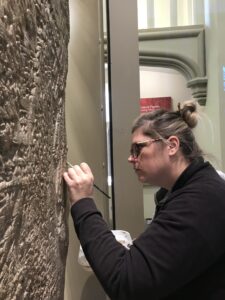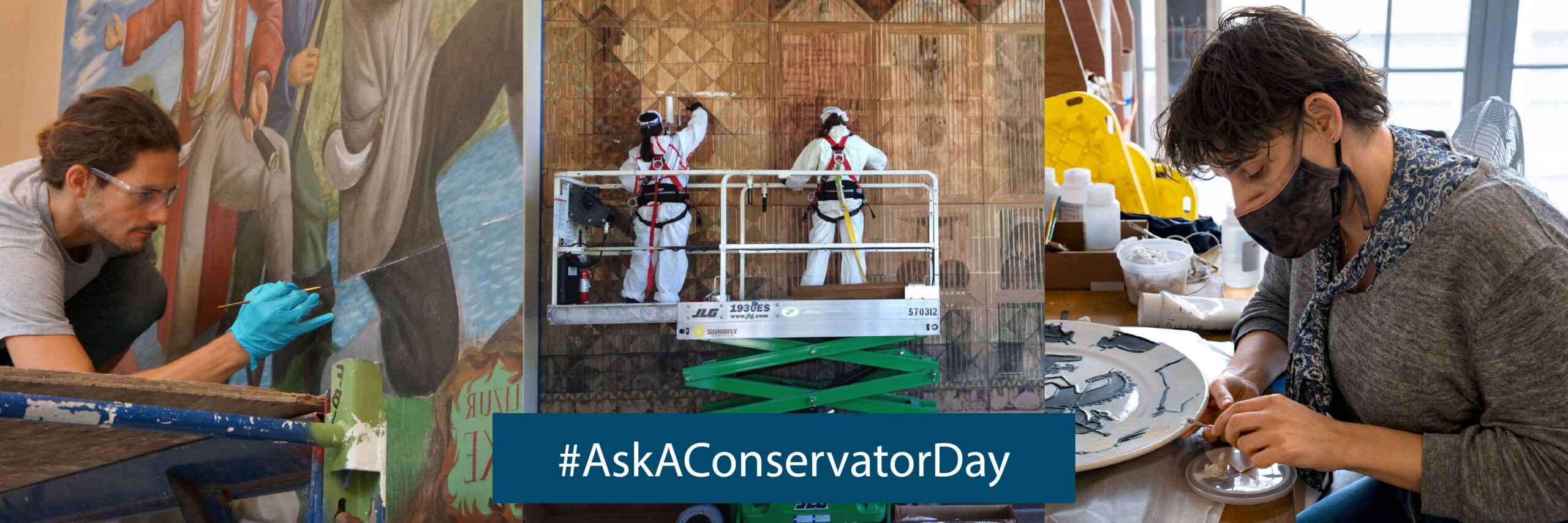Ever wonder what a conservator does day to day? For those of us who don’t work in the field, conservation is often shrouded in mystery. The American Institute for Conservation (AIC) is here to help! To encourage the exchange of knowledge among conservators and the general public around the world, the AIC promotes Ask a Conservator Day, which is celebrated every November. This global initiative offers the opportunity for dialogue about all things conservation!
As a leader in historic preservation with 2 AIC Fellows and 12 Professional Associates on staff, EverGreene is excited to participate in this educational campaign by sharing our expertise on social media. Members of our conservation team have provided their technical insight!
Follow along on our social media as our conservators answer your questions!
Scroll down this page for their full answers.
Q: What is the process of revealing a mural that has been hidden under overpaint?
A:
The presence of a mural beneath overpaint is often determined by examining archival photographs that record the original location of the mural, which was painted over at a later date. Alternatively, the mural may be partially revealed because post-historic overpaint has deteriorated or fallen away from discrete locations, or a feature has been removed that previously obscured a portion of the mural that was not subsequently overpainted, such as a partition wall or a ceiling covering. Removal of overpaint can be achieved in a number of ways, generally falling under the categories of mechanical (dry) and solvent (wet) removal. First, the surface is examined under raking light to determine whether mural paint layers are “telegraphing” or “ghosting” through the overpaint layers, which helps in locating painted mural features; often, this technique leads to the discovery of historical figurative or decorative paint which was previously unknown.
If overpaint layers cleave cleanly away from the mural surface, mechanical overpaint removal is often the best way to reveal the mural. One mechanical method involves scraping with a sharp steel blade (such as a surgical scalpel), where the blade is placed between the mural and the overpaint to push or “pop” the overpaint away at the cleavage interface. Another mechanical method, known as “strappo,” utilizes an adhesive such as tape, or a system created by adhering cloth or paper on the surface and allowing it to dry. The adhesive is then pulled off the surface, taking the overpaint off to reveal the mural. Mechanical methods have the advantage of not dissolving or softening mural paint surfaces; however, mechanical techniques can be too aggressive for degraded or thin mural paint layers.
Where there is not a clean cleavage interface between mural and overpaint layers, solvent removal can be more appropriate. With this technique, different solvents and chemicals are tested to determine a successful method for removing overpaint without obliterating original mural paint. Sometimes, more than one solvent is necessary to remove different overpaint types (such as oil, latex, and casein paints). Testing determines the optimal solvent materials and dwell times for removing overpaint, which is softened by the solvents and carefully scraped or wiped off. While this technique allows for more precise control of overpaint removal, post-historic layers can be more resistant to solvents than the mural paint, and great care must be taken in applying solvents, especially to fragile mural surfaces.
–Mary Slater, Senior Conservator
Q: What role does microscopy play in conservation?
A:
–Katharine George, Assistant Conservator | @kgg.jpg
Q: How much time does the investigation, testing, and analysis stage of a project typically take?
A:
This can be a whole project in itself. Proper investigations and documentation can help to develop and streamline treatments.

–Kelly Caldwell, Director of Conservation | @revenland
Q: What is distemper paint? How is it conserved?
A:
In the past, distemper coatings were often used in the decorative arts. Distempers are weakly-bound paints consisting of pigments bound in animal-based glue or proteins. One advantage of distemper paints is that they could be applied immediately to dried, freshly applied plaster; otherwise, the plaster would need to be fully cured before paints could be applied. Therefore, distempers are often the first paint coating applied to historic interior surfaces. They are especially compatible with lime plaster because they have similar physical characteristics, including thermal expansion coefficient and permeability. Distemper paints are frequently dead flat in appearance, lacking the glossier qualities imparted by resins found in oil paints and emulsions. They were favored for decorating churches, theaters, and other highly ornamented spaces, where painters mixed distemper paints by hand using colorfast earth pigments.
Presenting distemper paint decorations are vulnerable to deterioration stemming from the degradation of the paint binders (which renders them powdery and easily rubbed off) and from water damage from leaks, splashes, or surface cleaning. Conservation approaches include consolidation and re-saturation of powdery paint with a compatible material such as agar gel. In some cases, it may be advisable to apply a protective, clear barrier coating to prevent further damage and visually unify colors and surface sheen.
Because they are water-soluble, distempers can be removed easily when a new decoration is desired. Distempers do not provide a receptive surface for other types of coatings, and therefore were often washed off prior to the application of oil-based paints; consequently, historic decorative campaigns rendered in distemper can be absent from paint stratigraphies. Where distemper layers are intact, moisture intrusion can solubilize these layers and cause detachment of the paint from the substrate. Paint swells and contracts in response to changes in temperature and humidity and the degree of expansion and contraction varies with each type of paint (distemper, oil, alkyd, latex, acrylic, etc.). Where multiple layers of overpaint in various media exist, the potential for paint instability increases, due to the varying reactions of these materials to environmental fluctuations. This incompatibility of coatings is often the cause of the ongoing deterioration of paint on historic surfaces.
